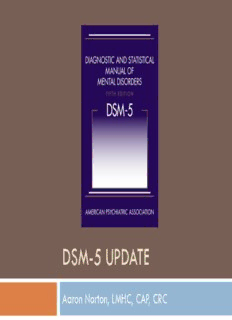
DSM-5 Update - Aaron Norton, LMHC PDF
Preview DSM-5 Update - Aaron Norton, LMHC
DSM-5 UPDATE Aaron Norton, LMHC, CAP, CRC What We’ll Cover… Brief Snapshot: Overview of Changes Sample of Perspectives on “Controversy” of DSM-5 Overview of Section II Chapter Changes Overview of Section II Disorder Changes (with exploration of how changes in Autism and Substance Use Disorders may impact VR Counselors) Questions, Comments, Ideas Disclaimers This is not an exhaustive review, but it should cover most of the significant changes It is not my role to tell VR Counselors how to perform their job duties or implement their agency’s internal policies or best practices. Consult internally Primary source: “Highlights of Changes from DSM-IV to DSM-5,” APA. All other sources will be reference through hyperlinks My opinions will be clearly delineated as my perspective, not fact DSM-5 is new; we’re all still learning it (myself included) The purpose of including information about “controversy” surrounding the DSM-5 is not to endorse or promote any perspective; it is to increase awareness by exploring a range of perspectives Why Do We Have a DSM? “The primary purpose of the DSM-5 is to assist trained clinicians in the diagnosis of their patients’ mental disorders as part of a case formulation assessment that leads to a fully informed treatment plan for each individual” (APA, 2013; p. 3) American Psychiatric Association (2013). Desk Reference to the Diagnostic Criteria From DSM-5. American Psychiatric Publishing: Washington, DC. Overview of Changes The term “general medical condition” replaced by the term “another medical condition” throughout the text Multiaxial classification system has been discontinued Global Assessment of Functioning (GAF) scale has been discontinued. Instead, more options for indicating severity have been worked into the individual disorders Overview of Changes Some chapters have been renamed Chapter order has been restructured Some chapter names have been eliminated and disorders have been reclassified under other chapters Some new disorders have been added; others have been revised or renamed; others have been removed or categorized as subtypes of another disorder Shift towards a spectrum classification vs. more rigid, dichotomous categories (e.g. autistic spectrum, substance use disorder) Overview of Changes Some instances of de-pathologizing (e.g. paraphilias vs. paraphilic disorders) Some new disorder classifications to capture individuals who need tx. but were technically just shy of meeting diagnostic criteria (e.g Mild Neurocognitive Disorder) Attempts at reducing the “Not Otherwise Specified” category due to greater depth of detail about symptoms. You’ll now see verbiage like “Other Specified” or “Unspecified.” My, My, The “Controversy!” Federal Mental Health Agency to Drop DSM Use (NBC, 5/3/13) The DSM-5 is here: What the controversial new changes mean for mental health care (Fox News, 5/21/13) Chorus of critics greets new psychiatric manual release (NBC, 5/17/13) Controversial update to psychiatry manual, DSM-5, arrives (CBS News, 5/18/13) Reflection on DSM V: 'Being Human is Itself Fast Becoming a Condition’ (MedPage Today, 5/6/13) Psychiatrists under fire in mental health battle (The Guardian [UK], 5/11/13) Controversial psychiatry 'bible' about to launch (Canada.com, 5/23/13) Two Fatal Technical Flaws in the DSM-5 Definition of Autism (Huffington Post, 5/25/13) Grief Differs From Depression: Our Mental Health Guidelines Should Clarify, Not Distort (Huffington Post, 5/22/13) The new DSM-5 fails to accurately describe mental illness (Fox News, 5/22/13) Goodbye to the DSM-5 (Huffington Post, 5/22/13) “The goal of this new manual, as with all previous editions, is to provide a common language for describing psychopathology. While DSM has been described as a “Bible” for the field, it is, at best, a dictionary, creating a set of labels and defining each. The strength of each of the editions of DSM has been “reliability” – each edition has ensured that clinicians use the same terms in the same ways. The weakness is its lack of validity. Unlike our definitions of ischemic heart disease, lymphoma, or AIDS, the DSM diagnoses are based on a consensus about clusters of clinical symptoms, not any objective laboratory measure. In the rest of medicine, this would be equivalent to creating diagnostic systems based on the nature of chest pain or the quality of fever. Indeed, symptom-based diagnosis, once common in other areas of medicine, has been largely replaced in the past half century as we have understood that symptoms alone rarely indicate the best choice of treatment.. Patients with mental disorders deserve better. ” Thomas Insel, Director, National Institutes of Mental Health Director’s Blog, 4/29/13 What Are Critics Alleging? Categories are arbitrary; not sufficiently based on underlying neurobiology “The weakness is its lack of validity,” - NIMH Director Thomas Insel (CBS News, 5/18/13) “Psychiatric diagnosis is often presented as an objective statement of fact, but is, in essence, a clinical judgment based on observation and interpretation of behavior and self-report, and thus subject to variation and bias” (British Psychological Society, 5/12/13) Pathologizing (e.g. Bereavement, Disruptive Mood Dysregulation Disorder) Changes in diagnosing autism may result in some children with Aspergers being pushed out of diagnosis Psychiatrists maintain monopoly on the classification system- tainted by “Big Pharma”
Description: